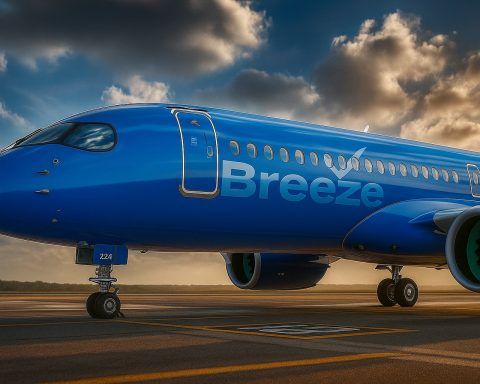Airline cancellations and delays surged again Sunday as the federal funding lapse squeezes air-traffic staffing and forces nationwide capacity reductions.
Date: Sunday, November 9, 2025
Key takeaways
- About 8,850 U.S. flight disruptions Sunday (1,975 cancellations + 6,875 delays “within, into or out of the U.S.” as of 3:28 p.m. ET), according to FlightAware. [1]
- FAA-ordered flight cuts are ramping up—4% started Friday, rising to 6% on Tuesday and 10% by Friday, Nov. 14, at 40 high‑traffic airports to preserve safety amid controller shortages. [2]
- Major hubs hit by ground‑delay programs include Atlanta, Newark, San Francisco, Houston, Washington National, among others, with average delays topping an hour at some fields. [3]
- Airlines are pre‑canceling and waiving fees; American says about 220 daily cancellations under the FAA directive, and Delta reported 470+ Sunday cancellations by noon ET with more likely. [4]
- Thanksgiving warning: The Transportation Secretary said air travel could be reduced to a “trickle” if the shutdown continues; 20% cuts are on the table if staffing deteriorates further. [5]
What’s happening today
Flight operations across the U.S. were snarled again Sunday as the government shutdown strained air‑traffic control staffing and triggered mandatory, rolling schedule reductions. FlightAware’s live dashboard showed 1,975 cancellations and 6,875 delays affecting flights within, into or out of the U.S., totaling about 8,850 disruptions by mid‑afternoon. [6]
The Federal Aviation Administration (FAA) began a phased cut to flight activity Friday—4% initially, rising to 6% on Tuesday and 10% by Friday, Nov. 14—at 40 of the country’s busiest airports. Officials say the measures are a safety backstop as more unpaid controllers miss shifts during the record‑long shutdown. [7]
Where the pain is sharpest
The FAA also imposed ground‑delay programs at multiple major hubs in recent days. On Friday, the agency cited staffing shortages at 10 facilities and delayed flights at eight airports, including Atlanta (ATL), San Francisco (SFO), Houston Bush (IAH), Washington National (DCA), and Newark (EWR). Average delays under those programs hit 83 minutes at DCA, 66 minutes at SFO, 52 minutes at EWR, 80 minutes at IAH, and 47 minutes at Austin (AUS)—a preview of the system strain travelers are now seeing through the weekend. [8]
How airlines are responding
Carriers have been pre‑canceling schedules to comply with the FAA directive and issuing broad travel waivers so customers can rebook or refund more easily:
- American Airlines says the FAA requirement translates to about 220 cancellations per day through Monday across the 40 airports; AA has waivers and is notifying affected customers. [9]
- Delta Air Lines reported more than 320 mainline and 150 Delta Connection cancellations by 12:00 p.m. ET Sunday, citing both the FAA cuts and controller‑driven delay programs; Delta is allowing changes and refunds including for basic fares during the impacted period. [10]
Industry groups and airline statements continue to urge a swift end to the shutdown as recovery will lag even after funding is restored due to aircraft and crew displacement. (See carrier updates and waivers linked above.) [11]
Why this is happening
The shutdown—now well over a month old—has forced 13,000 air traffic controllers and 50,000 TSA officers to work without pay, with 20%–40% controller absences reported on some days. To maintain safety margins with fewer certified controllers available, the FAA is throttling the system via scheduled cuts and tactical delay programs. [12]
Transportation Secretary Sean Duffy said Sunday that if the shutdown persists and absenteeism increases when another paycheck is missed, flight reductions could reach 20%, warning that Thanksgiving‑week travel might be reduced to a “trickle.” [13]
The 40 airports facing FAA cutbacks
The Associated Press published the FAA’s full list of affected airports, spanning major hubs like ATL, JFK, LAX, ORD, DFW, IAH, MIA, SEA, SFO, EWR, DCA/IAD, BOS, PHL, PHX, MSP, LAS, SLC, and more, plus certain busy reliever and regional fields. Travelers booked to/from these airports should expect continued schedule changes. (See AP’s full list.) [14]
What travelers should do right now
- Check your flight status often in your airline’s app and enable push alerts; schedules are being adjusted repeatedly as FAA programs update. (American, Delta) [15]
- Use travel waivers: Most major U.S. airlines have change‑fee/fare‑difference waivers for trips through the impacted dates. (American, Delta) [16]
- Know your refund rights: Under U.S. DOT rules, if the airline cancels or significantly changes your flight and you choose not to travel, you’re entitled to a refund to your original form of payment. Start with the airline; if denied, file a complaint with DOT. [17]
- Aim for earlier, nonstop flights and avoid tight connections where possible; recovery can take longer when crews and aircraft go out of position. (Operational guidance reflected in FAA/airline notices.) [18]
- Arrive early for security: TSA staffing pressures can amplify wait times, particularly at peak hubs on peak days. [19]
What’s next
- Tuesday: FAA’s targeted reductions step up to 6% system‑wide at the designated airports. [20]
- Friday, Nov. 14: Plan calls for 10% cuts unless funding is restored and staffing stabilizes. [21]
- Thanksgiving window: Officials caution the system could slow to a “trickle” if controller staffing worsens; travelers should build extra cushion into plans and watch for expanded waivers. [22]
Methodology & sources used for this update
This report synthesizes FAA directives, live flight‑status data, and airline operational updates published Sunday, Nov. 9, 2025. Figures are dynamic and may change as the day progresses.
Primary sources: FlightAware live statistics; Reuters dispatches on FAA directives and staffing; Associated Press list of affected airports; airline newsroom updates (American, Delta); remarks from Transportation Secretary Sean Duffy. [23]
References
1. www.flightaware.com, 2. www.reuters.com, 3. www.reuters.com, 4. news.aa.com, 5. www.reuters.com, 6. www.flightaware.com, 7. www.reuters.com, 8. www.reuters.com, 9. news.aa.com, 10. news.delta.com, 11. news.aa.com, 12. www.reuters.com, 13. www.reuters.com, 14. apnews.com, 15. news.aa.com, 16. news.aa.com, 17. www.transportation.gov, 18. www.reuters.com, 19. www.reuters.com, 20. www.reuters.com, 21. www.reuters.com, 22. apnews.com, 23. www.flightaware.com





